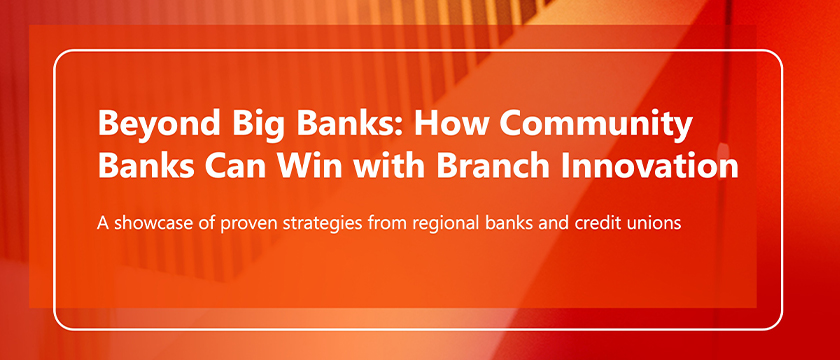Beyond Big Banks: How Community Banks Are Winning with Branch Innovation

Branch expansion intent jumped from 29% to 35% year-over-year with credit unions leading at 61% (Financial Brand).The days of assuming sophisticated branch strategies are exclusive to big banks are over. Regional banks, community banks, and credit unions aren’t just keeping pace—they’re setting the innovation standard. While large institutions focus on scale, smaller players are winning through strategic thinking applied to local advantages.
The shift is fundamental. These institutions are moving beyond transactional branch banking toward strategic investments in technology, personalization, and targeted physical presence that create genuine competitive advantages. Surveys show people visit branches to open accounts, resolve complex problems, and seek financial guidance—these aren’t transactions, they’re relationship-building opportunities.
We’ve assembled a showcase highlighting recent strategic innovations from regional banks and credit unions utilizing location intelligence, local connections, digital integration and relationship building to pave new paths in customer-centric banking.
Here are a few highlights of five innovation strategies and the financial institutions that are making them happen. Download the full report here.
Five Innovative Branch Strategies Driving Results
1. Location Intelligence Gets Sophisticated
Traditional metrics like traffic patterns and physical accessibility are no longer enough. Today’s successful institutions use “Location Intelligence” technology platforms that can assess any location-related business problem through data, methodology, and interpretation.
Fifth Third Bank exemplifies this evolution. According to Fifth Third, it applies trillions of calculations from thousands of data points, including anonymized cell phone data and retail destination patterns. Their sophisticated process factors in everything from road structure to staff recruitment capabilities—and it’s paying off with their goal of achieving 8% location share in new markets, according to Fifth Third’s James Anthos. See the detailed breakdown of their geospatial approach report below.
2. Local Customization = Competitive Advantage
Community banks and credit unions have a built-in advantage that big banks can’t replicate—deep local knowledge. Smart institutions are leveraging this through customization that spans visual design, interior layouts for specific customers cohorts and community integration. UniBank’s Worcester branch exemplifies a unique customization. Positioned across from Polar Park, they incorporated baseball-inspired graphics throughout the space, connecting directly to their partnership in bringing the Worcester Red Sox to the city. Meanwhile, OceanAir Federal Credit Union took a different approach, partnering with Dunkin’ Donuts to transform their 4,700 square foot branch into a vibrant community space that drives unprecedented traffic and brand exposure. Both detailed case studies with interior photos are featured in our showcase.
3. Digital Integration Without Losing the Human Touch
Banking transactions are increasingly handled through self-service kiosks, ITMs, and video banking, but this isn’t about replacing humans—it’s about freeing them up for higher-value interactions. As Marc Healy from The Element Group, a firm that designs, builds and remodels banks notes, “Digital users have come to expect their in-person customer service experiences to be just as fast, convenient, and hassle-free.”
GECU Federal Credit Union demonstrates comprehensive digital integration done right. Their branch features interactive kiosks, stretch screens, conversation towers for teller support and drive-thru ITMs, all strategically designed to enhance member engagement while maintaining the personal touch. Check out our showcase to see how GECU brings it together.
4. Advisory Focus Drives Value
Here’s a statistic that should grab every branch manager’s attention: 63% of customers prefer branches for solving “significant and complicated financial problems.” (Accenture Global Banking Consumer Study) This makes branch interactions particularly valuable when dealing with complex financial matters.
Physical space is evolving to support this shift. SF Fire Credit Union’s transformation from traditional teller barriers to flexible “service spots” demonstrates this perfectly. Their modular approach allows bankers to meet customers anywhere in the branch, with spaces that can accommodate both quick transactions and in-depth conversations. The before-and-after photos in our showcase show exactly how they reimagined their space for deeper customer relationships. Columbia Bank, nationally recognized for their branch experience, uses “perch” meeting spaces to give customers places to pause and collaborative spaces to allow bankers and customers areas to converse and interact.
5. The Universal Banker Evolution
Transactional roles are giving way to advisory roles, with staff increasingly acting as “Universal Bankers,” who combine traditional teller functions with personal banking expertise. This hybrid role requires employees to be conversant with all aspects of branch banking and capable of handling a broad set of customer requests.
Some institutions are already marketing this transformation. BankWest features actual “universal bankers” in their advertising, while Capital City Bank promotes face-to-face experience as “the best kind of facial recognition” made possible through featured Universal Bankers. You can see both campaign examples in the report below.
What’s Next: Three Emerging Branch Trends
Three emerging trends are shaping the future of branch banking for community institutions, representing significant opportunities for financial services marketers to differentiate their institutions, strengthen community ties and attract younger demographics who value authenticity and local connection over corporate polish.
AI as Enhancement, Not Replacement: The future lies in hybrid approaches that combine AI’s analytical power with human emotional intelligence. Facial recognition systems will enable personalized greetings, predictive analytics will optimize staffing, and AI will identify at-risk customers for proactive retention—but the relationship-building remains human.
Continuous Learning Over Traditional Training: Branch programs are shifting toward microlearning modules, soft skills development, and role-playing simulations. The emphasis is on adaptability, with robust feedback mechanisms and performance metrics driving improvement.
Reflecting Gen Z Values in Branch Design: Sustainability and cultural relevancy matter. Successful branches will incorporate eco-friendly elements, showcase local art and culture, and function as public spaces for community events.
The Bottom Line
The winners won’t be those with the most advanced technology or extensive branch networks. Success comes from blending multiple elements into compelling customer value propositions. Whether it’s Fifth Third’s sophisticated location analytics, UniBank’s baseball theme, or SF Fire’s flexible service spots, the common thread is strategic thinking applied to local advantages.
Regional banks, community banks, and credit unions aren’t just keeping pace with bigger players—in many cases, they’re setting the standard for what customer-centric banking looks like.
Ready to see these strategies in action? Flip through or download our full report for detailed case studies, interior photos and implementation insights from institutions leading the way in branch innovation.








